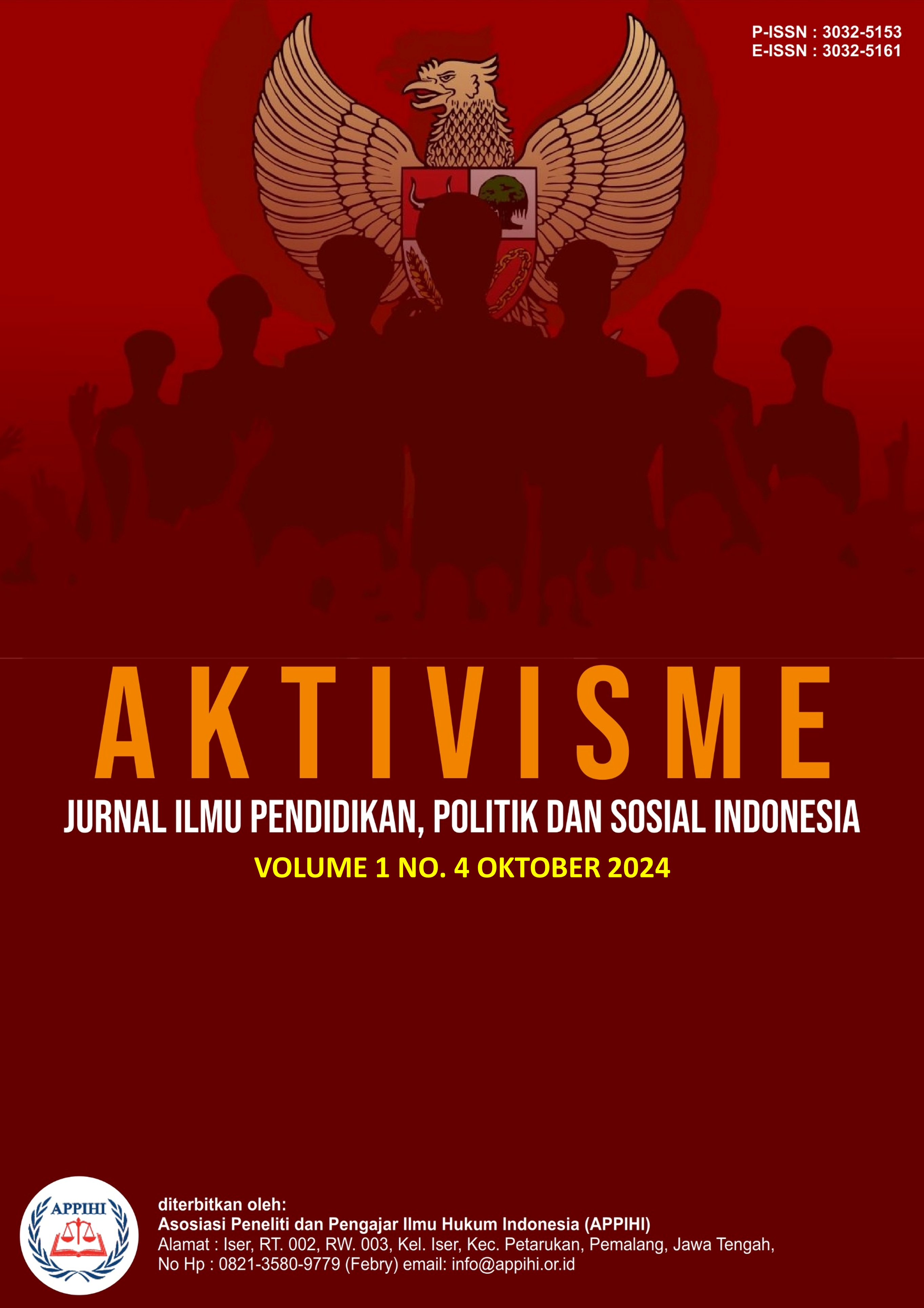Propaganda Partai Hijau dalam Perspektif Green Politics Terhadap Dampak Perubahan Iklim di Australia
DOI:
https://doi.org/10.62383/aktivisme.v1i4.491Keywords:
Climate, Australia, Propaganda, Green Party, Green PoliticsAbstract
The background of this research focuses on the impact of climate change in Australia, caused by extreme temperature fluctuations that have resulted in various social, environmental, and economic consequences. This study is analyzed using Green Politics theory and Propaganda theory, both of which play a significant role in shaping policies and public perceptions related to these issues. The research method used is a descriptive qualitative approach, which guides the investigation to explore or capture the situation to be studied comprehensively, broadly, and in depth, specifically through the analysis of Green Party propaganda from the perspective of Green Politics concerning the impact of climate change in Australia. Data were collected through public documents, books, scientific journals, mass media, and websites accessed from the internet. The findings indicate that Green Politics theory provides an effective framework for understanding how environmental policies in Australia can be influenced by political ideologies and economic interests. Meanwhile, propaganda theory reveals that the propaganda techniques used by the Australian Green Party, as proposed by Harold Lasswell, have proven to significantly increase public awareness and support for more progressive climate policies, despite facing inherent challenges. This study concludes that the integration of these two theories offers deep insights into the political dynamics underlying responses to climate change in Australia.
Downloads
References
Australian Government. (2021). Climate Change Impacts on Australia's Biodiversity.
Australian Greens. (2024). Our Vision for a Green Australia. Diakses pada 3 Mei 2024, dari https://greens.org.au/vision
Bäckstrand, K., & Lövbrand, E. (2006). Planting trees to mitigate climate change: Contested discourses of ecological modernization, green governmentality and civic environmentalism. Global Environmental Politics, 6(1), 50-75.
BBC News. (2020). “What is Australia doing to tackle climate change?.”
Brown, L. (2019). "Climate Change Mitigation Policies of the Australian Greens: Evaluating Effectiveness." Journal of Climate Policy, 19(2), 233-252.
Brown, P. (2018). "The Impact of Political Campaigns on Environmental Legislation." Journal of Political Marketing.Bureau of Meteorology. (2020). Special Climate Statement 73—severe fire weather and record heat in spring 2019.
Bureau of Meteorology. (2020). Climate data services. Diakses dari http://www.bom.gov.au/climate/data
Creswell, J. W. (2008). Research Design Qualitative, Quantitative, and Mixed Methods Approaches (3rd ed). United States of America: SAGE Publication, Inc. 46.
Department of Industry, Science, Energy and Resources. (2020). Australia's emissions reduction targets.
Dovers, S., & Hussey, K. (2013). Adapting to climate change: Lessons from Australia’s recent millennium drought. Weather and Climate Extremes, 3, 38-44.
Environment and Climate Change Canada. (2019). "Canada's Changing Climate Report."
Environmental Justice Australia. (2023). “Climate Justice.”
Giddens, A. (1976). New Rules of Sociological Method: A Positive Critique of Interpretative Sociologies. London: Hutchinson.
Government of Canada. (2021). Climate Change and Canada’s Coasts.
Great Barrier Reef Marine Park Authority. (2020). Climate change and the Great Barrier Reef.
Green, J. (2020). "Renewable Energy Policies and the Australian Greens: A Pathway to Sustainable Future." Journal of Environmental Policy, 22(3), 145-163.
Hill, M., & Varone, F. (2020). The Public Policy Process (7th ed.). Routledge.
Hughes, T.P., Kerry, J.T., Álvarez-Noriega, M., Álvarez-Romero, J.G., Anderson, K.D., Baird, A.H., ... & Bridge, T.C. (2018). Global warming transforms coral reef assemblages. Nature, 556(7702), 492-496.
IPCC. (2021). Climate Change 2021: The Physical Science Basis. Intergovernmental Panel on Climate Change.
IPCC. (2021). Intergovernmental Panel on Climate Change. Diakses dari https://www.ipcc.ch/
Johnson, A. (2020). "Environmental Justice in the Policy Framework of the Australian Greens." Social Justice and Environmental Sustainability Journal, 12(2), 101-120.
Jonathan S, Rasmus K. (2015). Green political theory in a climate-changed world: between innovation and restraint. Taylor & Francis.
Kothari, C. (2004). Research methodology: Methods and techniques (2nd revised edition). New Delhi: New Age International (P) Limited, Publishers.
Lesley Head, Michael Adams, Helen V McGregor, Stephanie Toole (2014). Climate Change and Australia. Wiley Interdisciplinary Reviews: Climate Change.
Lohmann, L. (2008). Carbon trading, climate justice and the production of ignorance: Ten examples. Development, 51(3), 359-365.
Miles, M. B., & Huberman, A. (1998). Analisis Data Kualitatif Buku Sumber tentang Metode-Metode Baru. Jakarta: Universitas Indonesia.
Miller, D. (2017). "Sustainable Agriculture and Food Security Policies of the Australian Greens." Journal of Agricultural Policy, 24(3), 189-207.
Ministry of Agriculture and Farmers Welfare India. (2021). Impact of Climate Change on Agriculture and Food Security.
NASA. (2021). Climate Change: How Do We Know?
National Snow and Ice Data Center (NSIDC). (2021). Arctic Sea Ice News & Analysis.
Sabatier, P. A., & Weible, C. M. (Eds.). (2014). Theories of the Policy Process (3rd ed.). Westview Press..
Smith, J. (2020). "Propaganda Partai Hijau Australia: Peran Media Sosial dalam Menyoroti Dampak Perubahan Iklim." Jurnal Politik Lingkungan, 14(3), 102-120.
Smith, K. (2018). "Biodiversity Conservation and the Australian Greens: Strategies and Challenges." Biodiversity and Conservation Journal, 27(4), 829-848.
Stewart, R., Westra, L., & Sisson, S. (2019). The Green Party in Australia: Its role and influence. The Australian Journal of Political Science, 54(1), 59-74.
Sugiyono. (2017). Metode Penelitian Kuantitatif, Kualitatif, dan R&D. Alfabeta..
Taylor, M. (2021). "Circular Economy and Waste Management: The Green Approach of the Australian Greens." Journal of Environmental Management, 30(1), 67-85.
The Australian. (2024). “Anti Voice Activists to Target Greens.”
The Greens. (2021). Environment
The Guardian. (2021). Australian Party’s Climate Policy And Stance.
Thompson, P. (2018). "Climate Adaptation Strategies of the Australian Greens: Building Community Resilience." Journal of Environmental Planning, 36(2), 89-110.
UNDP. (2021). Coastal and Marine Ecosystems.
UNFCCC. (2021). Paris Agreement. United Nations Framework Convention on Climate Change.
USDA. (2021). Climate Change and Agriculture in the United States.
White, R. (2017). "Education for Sustainability: The Role of the Australian Greens in Promoting Environmental Awareness." Journal of Environmental Education, 38(4), 297-315.
WMO. (2019). World Meteorological Organization. Diakses dari https://public.wmo.int/
World Bank. (2020). Climate Change Could Cost Indonesia 5.9% of GDP by 2050.
World Health Organization (WHO). (2018). Climate Change and Health.
Downloads
Published
How to Cite
Issue
Section
License
Copyright (c) 2024 Aktivisme: Jurnal Ilmu Pendidikan, Politik dan Sosial Indonesia

This work is licensed under a Creative Commons Attribution-ShareAlike 4.0 International License.





